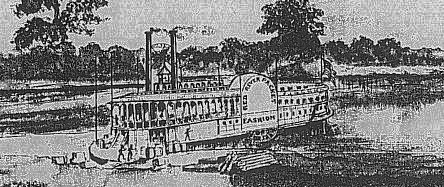
STEAMBOATS
The following information was taken from an article written by
Rita Moore Krouse,
BAYOU DAUCHITE: The Ante-bellum Lifeline of Claiborne Parish
The Steamboat "FASHION" on Bayou Dauchite

This painting of the steamboat, Fashion, at a landing
on Bayou Dauchite in 1852,
was done by Mrs. Sarah C. Hackett, Minden, Louisiana.
"The earliest boats to come up Dauchite Bayou were
small ones, with wooden hulls ranging from 106 to 120 feet long, 20 to 24 feet
wide, and 3 to 4 feet deep of hold. They were propelled by side paddle wheels
which were turned by a single cylinder low pressure (20 to 30 pounds) engine. By
1840 all new steamers were equipped with double engines, each engine, on the
side wheel boats, connected separately to the paddlewheel shafts."
"Because of the flimsy construction, risks taken in competitive racing, and
the natural hazards of the river, it was estimated that the average lifeof a
river steamer in the decades before the Civil War was no longer than four years.
The earlier steamboats were the work horses of the river, meant for cargo and an
occasional passenger. The 1850's introduced boats equipped, for that day, with
luxurious accommodations for passengers."
"Coming up the river, the steamboats brought all of the diversity of items
usually found in a general store--and sometimes more. There were barrels of
flour, sugar, molasses, coffee, whiskey, and preserved pork; boxes of yard
goods, shoes, tobacco,books, and broad brimmed beaver hats; bundles of iron rods
and bars; plows, accordians, sidesaddles and black lace mantillas; fiddlestrings,
fifes and pianofortes; pocketknives, padlocks, millsaw files, and packages
containing such unexpected items as cod-liver oil candy, and artificial flowers.
The list was almost endless. This cargo eas exchanged for such things as money,
beeswax, butter, bales of otterskins and beefhides, and the inevitable
cotton."